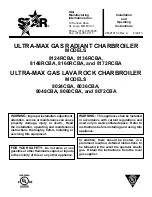
TROUBLESHOOTING
HeatNet Control REV 1.38-1
Page 62
Situation:
The boilers menu only indicates 1 boiler, but there
are member boilers connected and the amber light
blinks on all of the boilers communication’s jacks.
1.
Ensure that the latest version of firmware is installed on
all boilers. All boilers in a system must have the same
firmware revision.
2.
Ensure the proper termination is set on the Master and the
last Member boiler.
Situation:
You get the error message – WATER FLOW SWITCH
or WAITING FOR FLOW.
1.
If the control does not sense a closed circuit at input
connection, WTR FLW. Check to make sure the circuit
for the circulator pump is correct, that the pump is being
energized, and that the flow prove switch is working
properly.
2.
If there is no flow prove switch, the Local Flow interlock
can be disabled in the CONFIGURE INTERLKs menu.
Situation:
H-Net boilers are detected but then lost and then
detected again etc...
1.
The H-Net communications cable may be receiving
interference from the blower, ignition, or other form of
radiated electrical noise. Termination of the jumpers may
not be correct or there is more than one master.
a.
Ensure that the termination jumpers are set on the
MASTER boiler and only the LAST MEMBER
boiler. All of the other member boilers should have
their termination jumpers in the non-terminated
position.
b.
There may be (2) or more MASTER boilers. Ensure
that only one header sensor is present and connected
to the SYS/DHW input. There should be no wires or
sensors connected to the SYS/DHW input if the
boiler is operating as a member. This input is auto
detected and defines the boiler as a MASTER.
c.
Ensure the cable to connect the H-Net is of a shielded
or twisted pair type. Shielding of the cable is
required.
d.
Minimize the electrical interference by routing the
communications cable away from electrical noise
sources, such as: Motors, ignition controls, contactors
etc…
Situation:
Only the MASTER boiler Fires, but the system has
many boilers and is using H-Net.
1.
In order for the MASTER boiler to act as a MASTER, the
header sensor must be set to TYPEZ, and there must be a
header sensor present. At power-up, the header sensor is
auto detected. If the temperature of the header sensor at
power-up is greater than –25
°
F and less than 240
°
F it is
considered a valid sensor. The boiler will default to the
MEMBER mode if the temperature is not in this range
and can only be run locally or by external inputs.
a.
If the LOAD FACTORY DEFAULTS has been used
to restore all the default settings, the header sensor
has been set to NONE. This needs to be set as stated
in 1, and the header sensor will need to be replaced or
the temperature brought into a valid range. A power
cycle of the boiler will detect the sensor if it is in the
range as stated in 1.).
b.
The H-Net needs a communications cable daisy-
chained between boilers. Ensure that a good
connection is made on the communications board and
that the lights on the dual RJ45 jack flash (roughly
twice a second). The MASTER is the only one that
should flash with no communications cables plugged
in.
Situation:
I am in CALIBRATE and I cannot fire the boiler to
adjust it.
1.
Only one, but any one of the T1-T2 inputs can be
used to start the boiler. All other inputs are disabled.
This method prevents an external control or Building
Management System from trying to control the boiler
while it is offline and being calibrated. If the boiler is
being used as a staged boiler controlled by an
external control, the staged inputs need to be
disconnected before CALIBRATION, since more
than one of the T inputs may be closed by the
external control.
Situation:
You have forgotten the password.
1.
As a last resort, you can turn the controller off, then
depress and hold the ESC key while turning it back on.
This will load the default password “AAAAAA”.
Situation:
Firmware update program starts to load, but then
stops, or does not load at all.
1.
Check that the termination shunts J3 and J6 are not in the
termination setting. If they are, remove them temporarily
















































